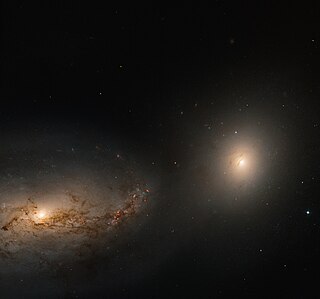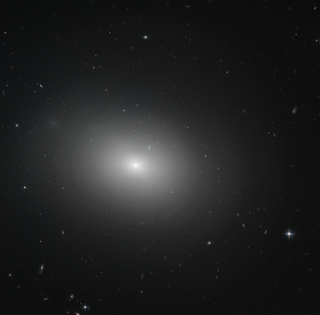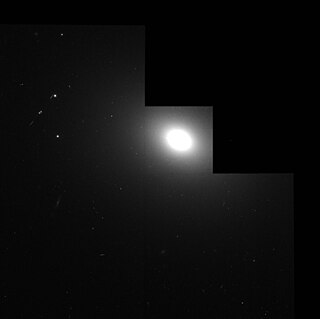An active galactic nucleus (AGN) is a compact region at the center of a galaxy that emits a significant amount of energy across the electromagnetic spectrum, with characteristics indicating that the luminosity is not produced by stars. Such excess, non-stellar emissions have been observed in the radio, microwave, infrared, optical, ultra-violet, X-ray and gamma ray wavebands. A galaxy hosting an AGN is called an active galaxy. The non-stellar radiation from an AGN is theorized to result from the accretion of matter by a supermassive black hole at the center of its host galaxy.

NGC 4395 is a nearby low surface brightness spiral galaxy located about 14 million light-years from Earth in the constellation Canes Venatici. The nucleus of NGC 4395 is active and the galaxy is classified as a Seyfert Type I known for its very low-mass supermassive black hole. It is one of the lowest

NGC 3227 is an intermediate spiral galaxy that is interacting with the dwarf elliptical galaxy NGC 3226. The two galaxies are one of several examples of a spiral with a dwarf elliptical companion that are listed in the Atlas of Peculiar Galaxies. Both galaxies may be found in the constellation Leo. It is a member of the NGC 3227 Group of galaxies, which is a member of the Leo II Groups, a series of galaxies and galaxy clusters strung out from the right edge of the Virgo Supercluster.

NGC 3226 is a dwarf elliptical galaxy that is interacting with the spiral galaxy NGC 3227. The two galaxies are one of several examples of a spiral with a dwarf elliptical companion that are listed in the Atlas of Peculiar Galaxies. Both galaxies may be found in the constellation Leo. It is a member of the NGC 3227 Group of galaxies, which is a member of the Leo II Groups, a series of galaxies and galaxy clusters strung out from the right edge of the Virgo Supercluster.

NGC 708 is an elliptical galaxy located 240 million light-years away in the constellation Andromeda and was discovered by astronomer William Herschel on September 21, 1786. It is classified as a cD galaxy and is the brightest member of Abell 262. NGC 708 is a weak FR I radio galaxy and is also classified as a type 2 Seyfert galaxy.

NGC 7469 is an intermediate spiral galaxy in the constellation of Pegasus. NGC 7469 is located about 200 million light-years away from Earth, which means, given its apparent dimensions, that NGC 7469 is approximately 90,000 light-years across. It was discovered by William Herschel on November 12, 1784.

NGC 3367 is a barred spiral galaxy located in the constellation Leo. It is located at a distance of about 120 million light years from Earth, which, given its apparent dimensions, means that NGC 3367 is about 85,000 light years across. It was discovered by William Herschel on March 19, 1784.

NGC 7130 is a spiral galaxy located in the constellation Piscis Austrinus. It is located at a distance of about 220 million light years from Earth, which, given its apparent dimensions, means that NGC 7130 is about 100,000 light years across. It was discovered by John Herschel on September 25, 1834, and discovered independently by Lewis Swift on September 17, 1897. The location of the galaxy given in the New General Catalogue was off by 30 arcminutes in declination from the location of the galaxy.

NGC 5982 is an elliptical galaxy located in the constellation Draco. It is located at a distance of circa 130 million light years from Earth, which, given its apparent dimensions, means that NGC 5982 is about 100,000 light years across. It was discovered by William Herschel on May 25, 1788.

NGC 7674 is a spiral galaxy located in the constellation Pegasus. It is located at a distance of circa 350 million light years from Earth, which, given its apparent dimensions, means that NGC 7674 is about 125,000 light years across. It was discovered by John Herschel on August 16, 1830.

NGC 3489 is a lenticular galaxy located in the constellation Leo. It is located at a distance of about 30 million light years from Earth, which, given its apparent dimensions, means that NGC 3489 is about 30,000 light years across. It was discovered by William Herschel on April 8, 1784. NGC 3489 is a member of the Leo Group.

NGC 4636 is an elliptical galaxy located in the constellation Virgo. It is a member of the NGC 4753 Group of galaxies, which is a member of the Virgo II Groups, a series of galaxies and galaxy clusters strung out from the southern edge of the Virgo Supercluster. It is located at a distance of about 55 million light years from Earth, which, given its apparent dimensions, means that NGC 4636 is about 105,000 light years across.

NGC 5846 is an elliptical galaxy located in the constellation Virgo. It is located at a distance of circa 90 million light years from Earth, which, given its apparent dimensions, means that NGC 5846 is about 110,000 light years across. It was discovered by William Herschel on February 24, 1786. It lies near 110 Virginis and is part of the Herschel 400 Catalogue. It is a member of the NGC 5846 Group of galaxies, itself one of the Virgo III Groups strung out to the east of the Virgo Supercluster of galaxies.

IC 1459 is an elliptical galaxy located in the constellation Grus. It is located at a distance of circa 85 million light-years from Earth, which, given its apparent dimensions, means that IC 1459 is about 130,000 light-years across. It was discovered by Edward Emerson Barnard in 1892.

NGC 4278 is an elliptical galaxy located in the constellation Coma Berenices. It is located at a distance of circa 55 million light years from Earth, which, given its apparent dimensions, means that NGC 4278 is about 65,000 light years across. It was discovered by William Herschel on March 13, 1785. NGC 4278 is part of the Herschel 400 Catalogue and can be found about one and 3/4 of a degree northwest of Gamma Comae Berenices even with a small telescope.

NGC 5363 is a lenticular galaxy located in the constellation Virgo. It is located at a distance of circa 65 million light years from Earth, which, given its apparent dimensions, means that NGC 5363 is about 100,000 light years across. It was discovered by William Herschel on January 19, 1784. It is a member of the NGC 5364 Group of galaxies, itself one of the Virgo III Groups strung out to the east of the Virgo Supercluster of galaxies.

NGC 765 is an intermediate spiral galaxy located in the constellation Aries. It is located at a distance of circa 220 million light years from Earth, which, given its apparent dimensions, means that NGC 765 is about 195,000 light years across. It was discovered by Albert Marth on October 8, 1864. The galaxy has an extensive hydrogen (HI) disk with low surface brightness, whose diameter is estimated to be 240 kpc.

NGC 2273 is a barred spiral galaxy located in the constellation Lynx. It is located at a distance of circa 95 million light years from Earth, which, given its apparent dimensions, means that NGC 2273 is about 100,000 light years across. It was discovered by Nils Dunér on September 15, 1867.

NGC 931 is a spiral galaxy located in the constellation Triangulum. It is located at a distance of circa 200 million light-years from Earth, which, given its apparent dimensions, means that NGC 931 is about 200,000 light years across. It was discovered by Heinrich d'Arrest on September 26, 1865. It is classified as a Seyfert galaxy.

NGC 5135 is a barred spiral galaxy located in the constellation Hydra. It is located at a distance of about 200 million light years from Earth. It was discovered by John Herschel on May 8, 1834. It is a Seyfert galaxy.




















